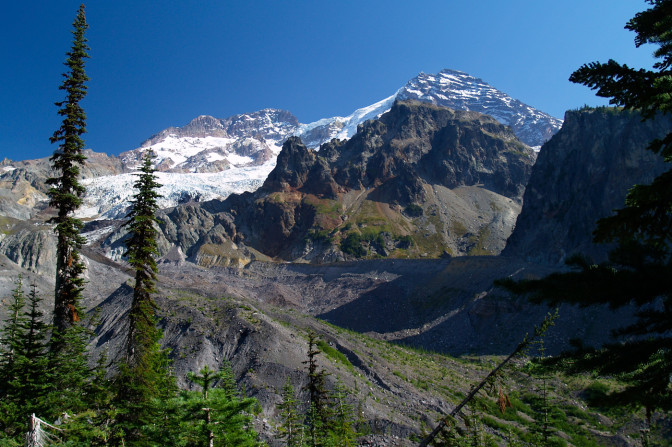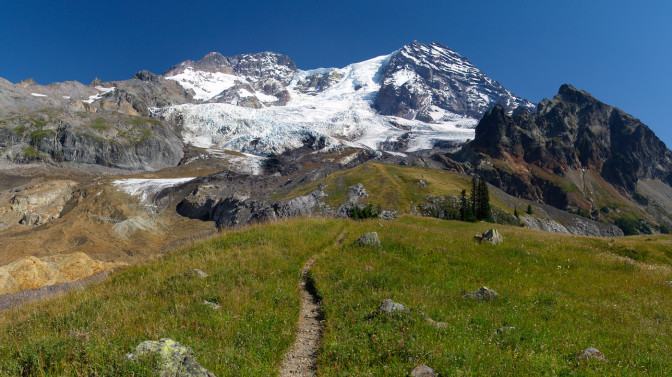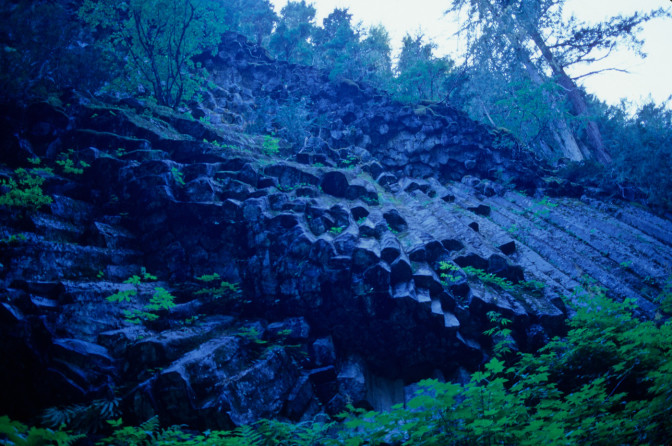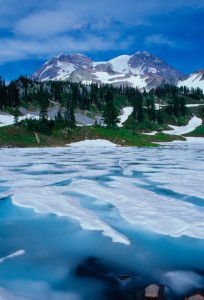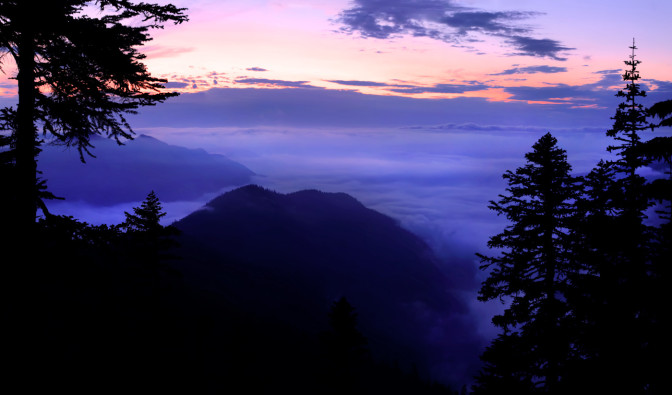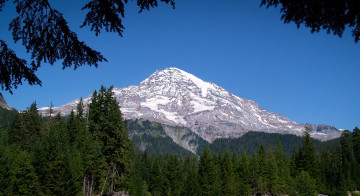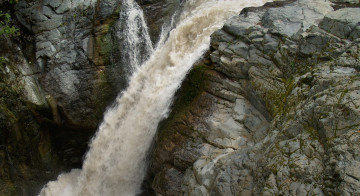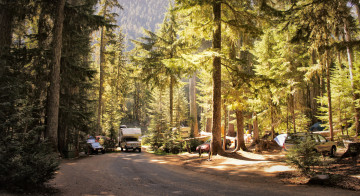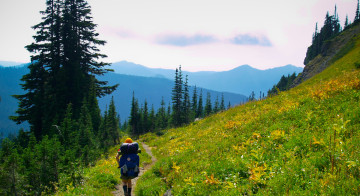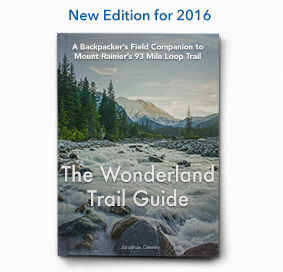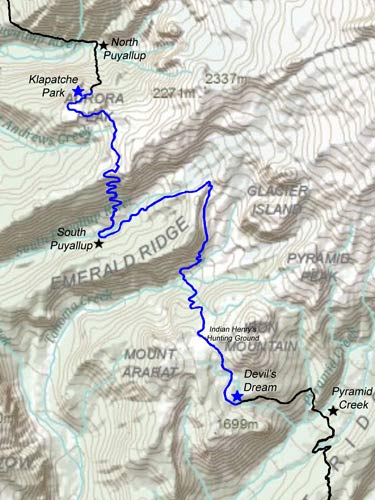
The start of a long day
If you stay at Devil’s Dream overnight, I recommend getting an early start. The section between Devil’s Dream and Klapatche Park has some spectacular highlights, and you will want some time to soak them up. But this leg of the Wonderland Trail makes for a challenging day, and if you don’t feel up for 10.2 miles of steep descents and long climbs, consider staying at South Puyallup River Camp (6.3 miles) rather than Klapatche Park.
Devil’s Dream to Indian Henry’s Hunting Ground
Leaving Devil’s Dream the trail climbs a short way to the sub-alpine meadows surrounding Squaw Lakes in the area known as Indian Henry’s Hunting Ground. This is one of my personal favorite stretches of trail in the park. You will pass an intersection with the Kautz Creek trail here which provides a 5.7 mile access route to the Nisqually-Longmire road.
Side-trip to Mirror Lakes
If you have the time, don’t miss the 0.6 mile side-trip to Mirror Lakes. The trail branches from the Wonderland Trail just past the ranger patrol cabin and goes NE across the meadows to some ponds that perfectly reflect Mount Rainier when the air is still.
Descent to Tahoma Creek
After passing the Mirror Lakes way-trail, the Wonderland Trail drops rapidly away from Indian Henry’s Hunting Grounds and descends 1.6 miles to Tahoma Creek. Here a large suspension bridge carries one high above a deep gorge where evidence of violent lahars may be readily observed. After crossing the canyon, the trail begins a steady and unrelenting climb to Emerald Ridge.
Climbing to Emerald Ridge
In about half a mile you will cross a small stream on a log bridge. Hydrate yourself well and top your bottles off before proceeding. This is the last source of water until you descend Emerald Ridge to the South Puyallup campground and you will need a lot to get over this dry, wind-whipped hump of tortured earth. The trail then begins a steady climb towards the ridge. It carries you hundreds of feet over an expanse of glacial moraine through which the headwaters of Tahoma Creek decorate like a ribbon of silver. On the far side of the valley, Glacier Island towers like a foreboding castle.
The Wonderland Trail aims directly at the base of Tahoma Glacier as it rises out of the stunted sub-alpine forests into barren grass and shrub-lands. In clear weather, the sun exposure intensified by the light reflecting the the glaciers and snow can be harsh and sun pomay be appreciated. Rising to the top of Emerald Ridge (5,600 feet), the sparse grass turns to a lush meadow surrounded by sweeping views of Tahoma Glacier as it rises towards the summit, framed to the north by the Puyallup Cleaver and to the south by Tahoma Cleaver.
From Emerald Ridge, the Wonderland Trail begins to descend the north side of the ridge – precariously in some places, hundreds of feet above the lower reaches of the glacier. The sounds of falling rock and ice echo through the vast chasm, punctuating the steady whistling of the breeze. Passing through patches of lupine, bellflowers, and paintbrush, the rocky trail winds more steeply down the hillside and the views begin to vanish behind the trees.
The Devil’s Pipe Organ
After dropping nearly 1,500 feet in elevation in over 2 miles, the hiker reaches a junction with the South Puyallup Trail. Take a moment to visit the remarkable andesite columns known as The Devil’s Pipe Organ located just 0.1 miles west from the Wonderland Trail on the South Puyallup Trail.
South Puyallup Camp to Saint Andrew’s Lake
The South Puyallup River camp is located at 4,000 feet and is sheltered in the trees alongside the canyon wall. For those headed to Klapatche Park, 3.9 miles ahead, the trail crosses high over the South Puyallup River and begins a 2+ mile switchback ascent to Saint Andrew’s Park (5,800 feet). At the top, Saint Andrew’s Lake tempts the weary traveler to stop and stay a while, but the cool prevailing westerly winds can quickly chill, and encourages one to move on. In dry months this is a good place to get water, as Klapatche Park’s water source is a little further on the funky side than some might like.
From Saint Andrews Park one can see Andrews Peak immediately to the SE, and Tokaloo Spire to the east. The trail continues on, curving westward as it carries one over a low saddle that affords one a glimpse of the North Puyallup Valley. Keep an eye out for wildlife, particularly foraging black bears in the brush below and above this saddle. From here, the trail skirts the southern slope of Aurora Peak not far below the summit, as it descends to Klapatche Park.
Aurora Lake at Klapatche Park Camp
Perched on a high plateau, Klapatche Park camp lies along Aurora Lake and steep cliffs that drop off to lowlands in the west. Framed by the lake and the surrounding hills, from here one is offered picturesque views when the mountain is out. Right alongside the western edge of the camp, the hillside drops away abruptly. With the trees and vegetation growing right up to the edge of the cliffs, one may not at first realize the extent of these heights. A careless trip to empty one’s bladder in the night could turn into a happy feast for the vultures and scavengers, so be wary of your location in the dark.
The sunset views from Klapatche Park can be excellent. When western Washington is socked-in and overcast you will likely be above it all to enjoy the sight of the rolling foothills of the Cascades vanishing below into an ocean of clouds. To the north, one may even see the aptly-named Golden Lakes (likely your next day’s destination) shimmering in the distance. Hopefully the sights make up for lack of good water at the camp. In dry summers, Aurora Lake can shrink into a murky mud puddle crawling with tadpoles and other aquatic life. This is Klapatche Park’s only water source and it’s an act of bravery to drop your water filter into something teeming with so many squirming critters. I chose to both filter and boil my water here and it still had an “off” taste. Someone suggested omitting the filtration step and just having pollywog soup. I recommend bringing in as much water as you’ll need from Saint Andrews Lake – you certainly won’t regret it.
The camp sites are semi-private and comfortable. Obese chipmunks wander from camp to camp looking for hand-outs and unattended foodstuffs, so as anywhere in the park, keep a close eye on your food whenever you don’t have it hanging on the bear pole.
